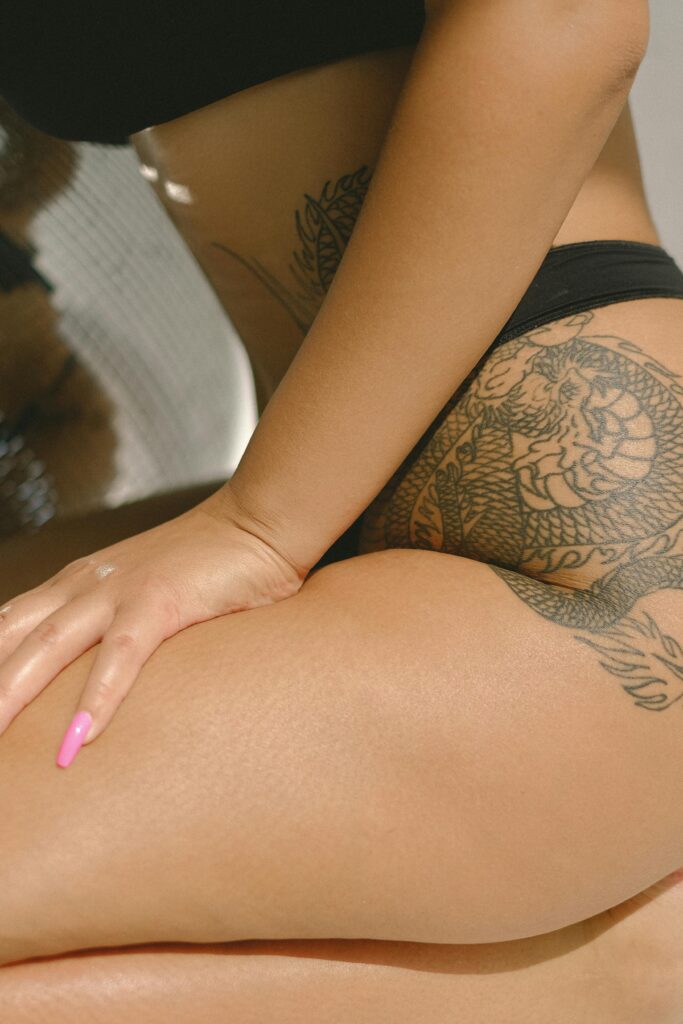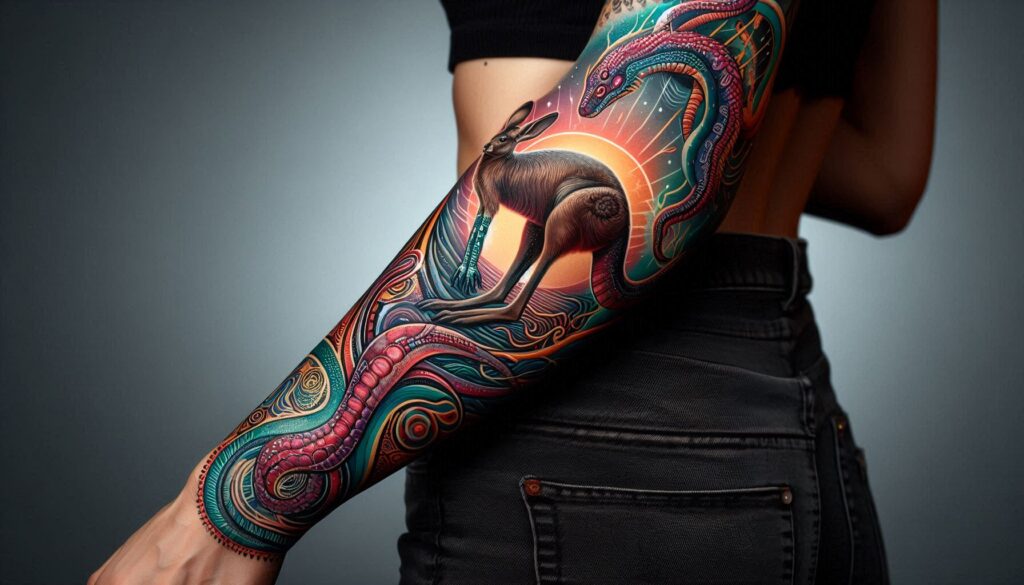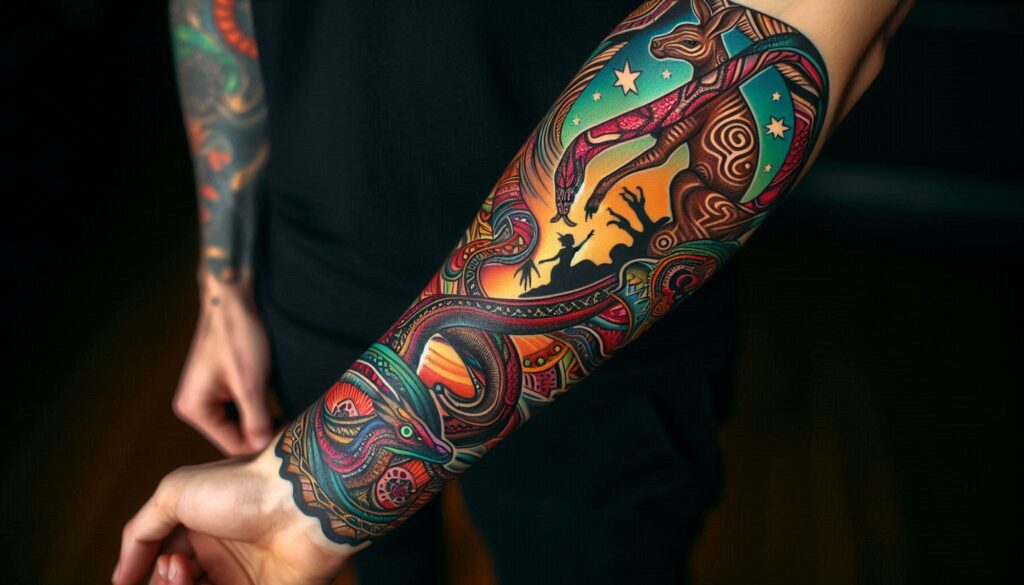Exploring the Influence of Australian Mythology in Tattoo Art
Tattoo art in Australia is as diverse as the country itself. It’s a canvas that tells stories, celebrates culture, and pays tribute to both personal and collective histories. While tattoos are often a reflection of an individual’s unique journey, there is an undeniable influence of broader cultural narratives, particularly Australian mythology, that seeps into the ink. These myths, deeply connected to the land, animals, and the Dreamtime—an integral aspect of Aboriginal spirituality—offer a rich well of inspiration for tattoo artists and enthusiasts alike.

Australian mythology isn’t just about ancient stories; it’s about how these stories continue to shape our relationship with the land and each other. In the world of tattooing, these mythologies are immortalized through symbols, designs, and intricate storytelling on skin. This article delves into the fascinating influence of Australian mythology in tattoo art, exploring its deep roots and modern interpretations.
The Power of Dreamtime in Tattoo Art
For Indigenous Australians, Dreamtime is the foundation of their belief system and worldview. It’s a concept that encompasses the creation of the world, the laws of the land, and the connection between all living things. Dreamtime stories are passed down from generation to generation and are as varied as the landscapes they originate from. Many of these stories explain natural landmarks, animal behaviors, and human existence itself, making them rich sources of inspiration for tattoo art.
Depicting Dreamtime Stories on Skin
In tattoo art, Dreamtime symbols are not just aesthetically pleasing but hold deep spiritual significance. One of the common motifs is the Rainbow Serpent, a creator god in many Aboriginal cultures. This powerful figure is often depicted as a snake winding through rivers, hills, and valleys, symbolizing fertility, renewal, and the life-giving power of water. When tattooed, the Rainbow Serpent becomes a personal emblem of transformation and connection to the natural world.
Another prominent figure is the Wandjina, rain and cloud spirits from the Kimberley region. With their large eyes and halo-like headdresses, Wandjina figures represent weather control and fertility, making them a popular choice for tattoos symbolizing protection and the nurturing aspects of nature. Artists skilled in Aboriginal-inspired designs often draw upon these sacred symbols, ensuring they are treated with respect and meaning.
Contemporary Interpretations of Dreamtime in Tattoos
While traditional designs stay true to their origins, modern interpretations of Dreamtime stories allow for more personalized adaptations. For example, some people choose to incorporate Dreamtime elements into their larger tattoos, blending them with other imagery to create a narrative that reflects both personal and cultural significance. It’s not uncommon to see Dreamtime symbols surrounded by more modern designs, like geometric shapes or abstract patterns, that give the ancient stories a contemporary twist.
Australian Fauna and Flora in Tattoo Art: More than Just a Symbol
Australia’s wildlife is unique and often serves as a symbol of the country’s identity. From the iconic kangaroo to the elusive platypus, Australian animals are revered not only for their uniqueness but also for the roles they play in various Dreamtime stories. Incorporating these animals into tattoo art brings an added layer of meaning, as many species are deeply tied to the land and Aboriginal mythology.
Animal Totems and Their Meanings
Many Aboriginal cultures believe in animal totems—creatures that serve as spiritual guides and protectors. Totems are chosen based on familial lineage, clans, or individual connection, and each animal represents certain traits or powers. In tattoo art, totems can be depicted to honor this spiritual connection.

The kangaroo, for instance, is more than just a national symbol. In many Indigenous cultures, the kangaroo represents strength, adaptability, and resilience. Tattoo designs of kangaroos are often stylized in a way that combines the animal’s natural form with elements of traditional Aboriginal art, such as dot painting or line work. This combination of styles creates a visual bridge between modern tattooing and ancient cultural traditions.
Similarly, the koala, often seen as a symbol of peace and relaxation, holds a different kind of reverence in some Dreamtime stories. For example, in some tales, the koala represents patience and the importance of slowing down to live in harmony with nature. Having a tattoo of this iconic marsupial can signify a personal reminder to embrace these qualities.
Mythical Creatures of the Land
Beyond real animals, Australian mythology also speaks of mythical creatures that inhabit the land. One such creature is the Bunyip, a mysterious water-dwelling beast believed to lurk in the swamps and billabongs of Australia. The Bunyip is often depicted in various forms, sometimes as an amphibious creature, other times as a more monstrous figure. Tattoo designs of the Bunyip tap into the eerie, mystical side of Australian mythology, appealing to those who wish to carry a piece of this ancient legend with them.
The Land Itself: A Sacred Canvas
Australia’s landscape is integral to its mythology, with landmarks often viewed as the physical manifestations of Dreamtime events. Uluru, for example, holds immense spiritual significance and is linked to numerous Dreamtime stories. The rock’s surface, with its caves and fissures, is said to be the physical record of these ancient tales. For many, tattooing imagery of Uluru or other sacred sites is a way to honor the land and its ancient stories.
The Landscape as Tattoo Inspiration
Tattoos inspired by the Australian landscape often incorporate elements such as desert dunes, sprawling bushland, and rugged coastlines. These designs can be minimalist or detailed, sometimes focusing on a single aspect of the environment, like a tree or rock formation, while other times expanding into larger pieces that evoke the feeling of the land as a whole.
For example, a tattoo depicting a lone eucalyptus tree swaying in the breeze may seem simple on the surface, but for those who understand the cultural context, it can represent resilience, survival, and the deep-rooted connection between the land and its people. Eucalyptus trees are often linked to the spirits in some Dreamtime stories, adding another layer of depth to the design.
The Role of Tattoo Artists in Preserving Mythology
Tattoo artists who specialize in designs inspired by Australian mythology play an important role in preserving these stories. Their work often goes beyond simple artistry; it’s about educating people on the rich history behind the designs. Many tattoo studios, such as Tattoo Down Under, offer consultations that delve into the meanings behind the symbols and stories their clients are interested in, ensuring that each tattoo is both visually stunning and culturally significant.
Cultural Sensitivity in Tattooing
It’s essential that tattoo artists approach Australian mythology with respect and sensitivity, particularly when working with designs rooted in Aboriginal culture. While it’s tempting to get a tattoo simply because it looks cool, understanding the cultural significance behind a design is key to honoring its origins. Tattoo studios like Tattoo Down Under make it a priority to educate clients on the importance of cultural appreciation rather than appropriation.

For non-Indigenous Australians, getting a tattoo inspired by Dreamtime stories or totems requires an understanding of the stories they’re embracing. Consulting with an artist who is knowledgeable about Aboriginal culture and mythology ensures that the tattoo will be respectful and meaningful. Additionally, many artists work closely with Indigenous communities or consult with cultural experts to make sure their designs remain true to their origins.
The Modern Interpretation of Mythology in Tattoo Culture
While traditional designs remain popular, modern interpretations of Australian mythology are also emerging within tattoo culture. These reinterpretations offer a way for people to connect with mythology in a way that feels personal and relevant to their lives today.
Some artists mix traditional symbols with contemporary elements, such as geometric shapes or watercolor techniques, creating tattoos that feel both ancient and modern. This fusion allows individuals to pay homage to Australia’s rich cultural heritage while also expressing their own creativity and individuality.
For example, a tattoo that incorporates both Dreamtime symbols and modern abstract art can tell a layered story—one that reflects not only the myths of the past but also the personal journey of the wearer in the present. This blending of styles is becoming increasingly popular in Australia’s tattoo scene, where people are looking to merge cultural tradition with contemporary aesthetics.
Tattoos as a Form of Cultural Expression
Ultimately, tattoos inspired by Australian mythology are more than just body art—they are a form of cultural expression. Whether it’s through the depiction of Dreamtime stories, animal totems, or sacred landscapes, these tattoos carry with them the weight of history and tradition. For many Australians, getting a tattoo that reflects the mythology of their land is a way to connect with their heritage and the natural world around them.

This connection to mythology and culture is something that tattoo artists in Australia, especially those at Tattoo Down Under, understand deeply. Their expertise in crafting designs that resonate with both personal meaning and cultural significance makes them a trusted choice for anyone looking to incorporate Australian mythology into their tattoos. Whether you’re looking for a traditional design or a modern interpretation, the team at Tattoo Down Under will guide you through the process with respect, creativity, and care.
In a world where tattoos are often seen as merely aesthetic choices, Australian mythology provides a powerful reminder that tattoos can also be deeply meaningful. They serve as a link between the individual and the collective stories that shape our understanding of the world—a timeless expression of identity, culture, and belief.


Leave a Reply